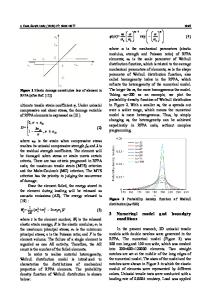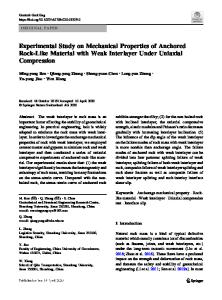Effect of weak intercalation on failure mode of rock slopes under seismic excitation
- PDF / 2,587,435 Bytes
- 19 Pages / 439.37 x 666.142 pts Page_size
- 66 Downloads / 266 Views
Effect of weak intercalation on failure mode of rock slopes under seismic excitation Zhenlin Chen1 · Xiao Hu1 · Xiangbo Bu2 Received: 18 April 2020 / Accepted: 7 September 2020 © Springer Nature B.V. 2020
Abstract To study the failure mechanism of a slope with weak intercalation under a seismic wave clearly is helpful to find out the starting mechanism of rock slope landslide. A distribution function of energy density was built to analyze the energy distribution of a seismic wave in a slope with weak intercalation; moreover, the function was used to investigate the failure phenomena observed in shaking table tests. The relationship of the seismic energy distribution and the failure mechanism was established by the theoretical analysis method. We further analyzed the effect of the thickness and dip angle of weak intercalation on the dynamic response of the layered slope. From the theoretical analysis, it was found that the stability of a counter-tilt slope with weak intercalation may be worse than that of a horizontal layered slope or a consequent bedding slope; furthermore, it was found that the tilt angle of weak intercalation is an essential factor in the failure mode of a rock slope. The proposed method can benefit research on detecting the failure region and failure mechanism of layered rock slopes. Keywords Rock slope · Weak intercalation · Seismic energy density · Failure mode
1 Introduction Recent research has focused on the propagation of stress waves in slope joints. One general conclusion is that the propagation and interaction of a stress wave in a rock slope with joints are the principal influence factors of stability under dynamic loads (Roy and PyrakNolte 1997; Zhao and Cai 2001; Fan et al. 2004). Most buckling failures of rock slopes * Xiao Hu [email protected] Zhenlin Chen [email protected] Xiangbo Bu [email protected] 1
State Key Laboratory of Geohazard Prevention and Geoenvironment Protection, Chengdu University of Technology, Chengdu 610059, China
2
Civil and Environmental Engineering Department, Polytechnic University of Catalonia, 08028 Barcelona, Spain
13
Vol.:(0123456789)
Natural Hazards
occur near structural surfaces, such as faultage, joints, and weak intercalation. When the strength of the shear stress exceeds the limit, slope instability results. In general, a seismic wave is decomposed into the transmission P-wave and SV-wave when it encounters a joint interface (Shi et al. 2009). A time-domain recursive method was proposed (Li et al. 2012); the propagation equation’s difference formal of the stress wave was established to analyze transient wave propagation across rock joints. Some researchers have also studied the transfer rule of energy under the oblique incidence of a P-wave on a group of parallel joints (Li et al. 2012; Zhu and Zhao 2013; Fan et al. 2012). Under a vertical shear wave excitation, the amplification effect was observed in the slope crest and the near-surface in the slope bottom (Lin and Wang 2006). In a slope surface, the amplification effect on
Data Loading...











